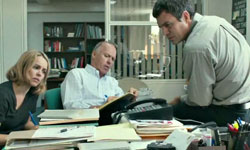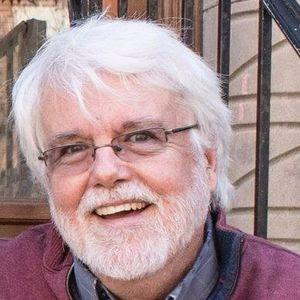 The new Spotlight movie opening in select cities this weekend is such a big deal in Boston that several university journalism programs staged special advance screenings earlier this week.
The new Spotlight movie opening in select cities this weekend is such a big deal in Boston that several university journalism programs staged special advance screenings earlier this week.
After failing to worm my way into any of those events, I showed up at Spotlight’s first public unveiling Thursday night. It’s showing at a theater just down the street from a couple of notable scenes in this stunning account of the Boston Globe’s investigation of clergy sexual abuse.
Crossing Tremont Street from the Boylston stop on the Green Line, I confessed to my wife, Carol, a parochial question I imagine one or two other journalists might share.
And that’s this: When the film comes up in discussion with family and friends at Thanksgiving Dinner in a few weeks, what impact will it have had on the public’s perception of journalists?
By the time the credits rolled, I had to agree with reviewers who’ve concluded that ink-stained, web-whipped wretches haven’t looked this good since All The President’s Men. That’s true as a result of both similarities and differences in the two movies. It’s the differences that render Spotlight a must-see not only for journalists but for the people they serve.
All the President’s Men put a David and Goliath morality tale in the hands of hugely popular actors — Robert Redford, Dustin Hoffman, Jason Robards — who proceeded to make investigative reporting appear not only cool but wildly successful. The president resigned.
The stars of Spotlight — Mark Ruffalo, Michael Keaton, Liev Schreiber, Rachel McAdams, Brian D’Arcy James — are just as cool but successful in different ways on a different stage.
Spotlight reveals just enough about the journalists to make them sympathetic, flawed and accessible. Their interactions with abuse survivors show them to be compassionate human beings as well as hard-charging investigators. Editors leading the charge in 2002 acknowledge failing to follow up on solid tips provided years before.
And unlike Watergate, a once-in-a-lifetime, only-in-Washington sort of blockbuster, clergy sexual abuse is a story that continues to unfold in hundreds of communities and newsrooms around the world. The film concludes, in fact, with a screen-after-screen list of cities and towns where the abuse drama erupted beyond Boston.
Before journalists get too excited about their Spotlight-enhanced status, it’s worth taking a look at the base line. Gallup surveys of the public’s perception of the honesty and ethical standards of people in various fields showed that just 24 percent ranked journalists highly or very highly in 2012. That compares with 2014 rankings of 80 percent for nurses, 46 percent for clergy and 21 percent for lawyers.
All of which raises the question of the connection between portrayal and perception.
Joe Saltzman, a USC journalism professor and co-author of the new book, “Heroes and Scoundrels: The Image of the Journalist in Popular Culture,” describes the linkage as mostly anecdotal but still valuable.
In an email exchange Thursday, he pointed to “decades of constant anecdotal evidence, plus every study done on the perception of doctors, lawyers, and other professions – including major research done on how images create perception among children.”
He also noted a dimension of the linkage that suggests good vibes for journalists among viewers of Spotlight:
My research shows that when the journalist is featured in a film or TV program and is played by a familiar actor, the image is favorable – much like Spotlight and All the President’s Men. If the journalist is the fifth person on the credits or lower, or simply anonymous, and played by an unfamiliar actor, the image is usually unfavorable.
For more on how we look to the public, see Saltzman’s comprehensive site, “The Image of the Journalist in Popular Culture.”
Frank Bruni, the New York Times columnist who co-authored a book a clergy sexual abuse in 1993, explained in a recent column how Spotlight’s core message transcends its treatment of journalists and the church:
(Spotlight) isn’t about journalism. Or, for that matter, about Catholicism. It’s about the damage done when we genuflect too readily before society’s temples, be they religious or governmental. It’s about the danger of faith that’s truly blind.
To the extent that one audience’s reaction might be an indicator, the silence followed by applause that greeted the movie’s final scene last night suggested the Oscar buzz surrounding Spotlight might be real.
The theater emptied unusually slowly, and my guess is that many of the people still seated around us had a personal connection to the experience of sexual abuse, a horror that continues to slice through so many lives.
I happened to be seated next to an abuse survivor, a woman who foreshadowed the still ongoing clean-up ahead in a 2002 piece for America Magazine.
As spot-on as Spotlight is in capturing the newsies, its carefully crafted snapshots of people preyed upon by priests are just as compelling. The film makes clear that it was survivors brave enough to tell their stories who ripped open the cloak the church draped around its predators.
But it was journalists who gave those stories voice, beginning with the National Catholic Reporter in 1985, The Phoenix, Boston’s now-shuttered atl weekly, followed by the Globe’s far bigger megaphone in 2002 and thousands of other news outlets to this day.
By the time we left the theater and headed home last night, I was left with one line — and one scene — that I hope journalists will heed and pursue with just the sort of dogged compassion portrayed in Spotlight.
The line: “If it takes a village to raise a child, it takes a village to abuse one.”
And the scene: The day after the presses roll with the Spotlight investigation, a mom and two kids gather in a cluttered conference room, preparing to tell their story of abuse.
Thanks to Denise-Marie Ordway of Harvard’s Journalist’s Resource for research help.
Bill Mitchell is a Poynter affiliate who launched the Clergy Abuse Tracker as director of Poynter Online and ran it from March 2002 until December 2003. The tracker is now hosted by BishopAccountability.org and is updated daily by the editor Mitchell recruited in 2002, Kathy Shaw.
Related: “Spotlight:” Boston Globe church-scandal movie spurs press introspection







